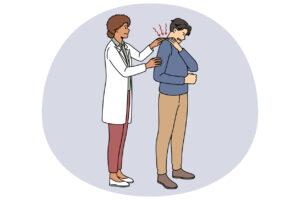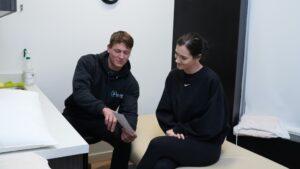
Have you ever experienced restrictive, intense pain in one side of your neck? Does the pain travel down to your shoulder blade? Is your head slightly tilted to the side with one shoulder higher than the other? If you’ve said yes to any of these symptoms, you might have encountered torticollis, often called “wryneck.” It’s no fun—this painful twist in your neck can be debilitating, creating an abundance of discomfort and limited neck movement.
Luckily, there are remedies you can do at home to ease the pain and exercises that can help you regain your range of motion. So, let’s dive into what torticollis is, what causes it, and how you can find some relief.
Getting to Know Torticollis
Torticollis is a condition where the muscles in your neck go into a kind of spasm, causing your head to twist or tilt unnaturally. There are two main types:
- Congenital Torticollis: This one starts from birth and often happens because of how you were positioned in the womb or due to some birth-related injury.
- Acquired Torticollis: The acquired version can show up later in life and has several potential causes such as muscle spasms, neck injuries, bad posture, or underlying health issues.
Root Causes of Torticollis
Understanding why torticollis is acting up in your life is a crucial first step to managing it. Let’s look at some common culprits:
Muscle Spasms: Sudden muscle spasms or contractions in the neck can cause the head to twist or tilt involuntarily.
Bad Posture: Maintaining improper posture for extended periods, such as slouching or hunching over a computer, can strain the neck muscles and lead to torticollis.
Neck Injuries: Trauma or injury to the neck, such as whiplash from a car accident or a sports-related injury, can result in torticollis.
Infections: Sometimes, infections like abscesses or upper respiratory infections can trigger torticollis.
Degenerative Conditions: Conditions like cervical spondylosis, which involve the wear and tear of cervical spine discs and joints, can contribute to the development of torticollis.
Home Remedies for Torticollis
While getting professional help is crucial if you are managing neck pain, there are some things you can do at home to relieve discomfort:
Heat and Cold Therapy: Applying heat or cold packs to the affected area can provide temporary relief from pain and muscle spasms. Use a hot water bottle or an ice pack wrapped in a cloth for 15-20 minutes at a time.
Neck Support: Using a supportive neck pillow while sleeping or sitting can help maintain proper neck alignment and reduce muscle strain.
Over-the-Counter Pain Meds: Non-prescription pain relievers like ibuprofen or acetaminophen can help with pain and inflammation. Remember to check with a healthcare professional before taking any medication.
Gentle Neck Stretches: Performing gentle neck stretches can improve neck flexibility and relieve muscle tension. Slowly tilt your head from side to side, forward, and backward, holding each stretch for 15-20 seconds.
Avoid Neck Strain: Pay attention to your daily activities and try to avoid activities that strain your neck, such as looking down at your phone or computer for extended periods.
Exercises for Neck Pain Relief
In addition to at-home remedies, performing specific exercises can help improve neck mobility and alleviate pain associated with torticollis. Remember to consult with your local Surrey physiotherapist before starting any exercise routine to ensure it’s safe and suitable for your condition. Here are some exercises that may help:
Neck Range of Motion Exercises:
- Neck Tilt: Gently tilt your head to the left and right, holding each position for a few seconds.
- Neck Rotation: Slowly turn your head to the left and right, maintaining a comfortable range of motion.
- Neck Flexion and Extension: Gently nod your head forward and backward, keeping movements slow and controlled.
Neck Isometrics:
- Place your hand on your forehead and push your head forward against the resistance of your hand for a count of five seconds. Repeat five times.
- Place your hand against the side of your head and push your head into your hand for a count of five seconds, both to the left and right. Repeat five times for each side.
Shoulder Blade Squeezes:
- Sit or stand with your arms at your sides.
- Squeeze your shoulder blades together as if trying to hold a pencil between them.
- Hold for five seconds, then relax.
- Repeat 10-15 times.
Schedule an appointment at Synergy Rehab to relieve your neck pain! 
Torticollis, or wryneck, is a pain in the neck (literally!), but there’s solutions to relieve your discomfort. Understanding what’s causing it and trying out these home remedies and exercises can help you find relief and regain your neck’s normal function. Remember, everyone’s situation is different, so talk to a physiotherapist or healthcare professional for a personalized plan. With a little care and perseverance, you’ll be back to enjoying life with your full range of motion!








